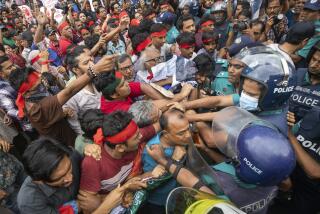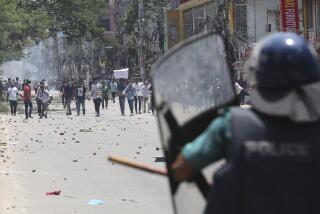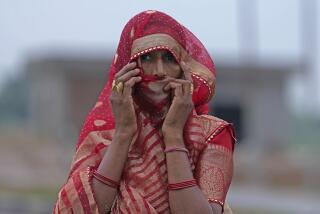112 Trampled to Death as Police Halt India March
- Share via
NEW DELHI — A charge by baton-swinging police on protesters from one of the most destitute groups in Indian society sparked a stampede Wednesday in which at least 112 people were trampled to death, officials said.
At least 500 people were injured in the panic in the city of Nagpur, Deputy Police Commissioner Jawahar Singh said.
Sources at the Government Medical College Hospital told the United News of India that the death toll could rise, as some of the injuries were very serious.
Among the dead were 68 women and 28 children, said Maharashtra Home Minister Padamsinh Patil. He said they had been placed in the vanguard of a march that tried to break through police barricades.
Early today, Indian police said they arrested three leaders of the protest to prevent an outbreak of violence in the wake of the tragedy. Authorities also banned meetings and marches and stepped up security in Nagpur.
The deadly stampede was directly linked to the campaigns mounted by an increasing number of groups in this country’s diverse society to demand the allocation of what they perceive as their fair share of government jobs, school admissions and other benefits.
The legislature of Maharashtra state, which normally meets in Bombay, had convened for its winter session Monday in Nagpur, 375 miles south of New Delhi. An estimated 50,000 adivasis , members of indigent, uneducated tribes that dwell in the western state’s forests and remote rural areas, had massed under the banners of the Adivasi Struggle Society to demand that they be given “scheduled tribe” status under Indian law.
“Scheduled tribes” are allocated quotas for government jobs and placement in state-run schools.
At present, the adivasis are classified as “other backward castes” in the Byzantine hierarchy of India’s many Hindu castes and other social strata. Such a designation, which by one estimate embraces four-fifths of India’s 900 million people, entitles the adivasis to far fewer privileges than if they were incorporated on the list of “scheduled tribes.”
Police sources said the trouble began when leaders of the protest insisted on taking a large delegation to meet with Maharashtra Chief Minister Sharad Pawar. When they were blocked, some marchers tried to smash their way through the barricades.
According to Patil, male demonstrators pushed the women and children forward to pull down the heavy police barricades and try to rush the Council Hall where the state lawmakers were meeting about a quarter-mile away. They also threw stones, Patil claimed.
Police charged, armed with long, iron-tipped shafts of bamboo called lathis . When the marchers in front tried to fall back to escape the blows, a stampede began, with many women and children falling under the feet of the panicked crowd.
Reporting from Nagpur, Reuters news agency quoted officials as saying many demonstrators ran into a small lane, which was blocked by a water tanker. It appeared many deaths occurred there, Reuters said.
The quarter-mile from the site of the tragedy to the police station was littered Wednesday night with torn clothes and discarded slippers and sandals. The area was cordoned off so the dead and injured could be evacuated.
Prime Minister P.V. Narasimha Rao, expressing shock and regret, asked Pawar, the state’s chief minister, to investigate the incident. But Patil defended police actions, saying, “Not a single bullet was fired or tear-gas shell used on the mob.”
This year, the issue of job quotas has inflamed Indian politics from the southern state of Tamil Nadu to Uttar Pradesh, the northern state astride the Ganges that is the country’s most populated.
India’s most downtrodden, including the harijan , or Untouchables, say they are only trying to get social justice after centuries of discrimination and oppression.
But the priestly caste, known as Brahmins, and other higher-caste groups that have historically held power and prestige complain that merit is less and less a requirement for holding government office or getting into competitive government-run schools.
By making caste a criterion for being hired, they say, members of castes that were traditionally regarded as inferior or impure are perpetuating those stereotypes.
More to Read
Sign up for Essential California
The most important California stories and recommendations in your inbox every morning.
You may occasionally receive promotional content from the Los Angeles Times.













